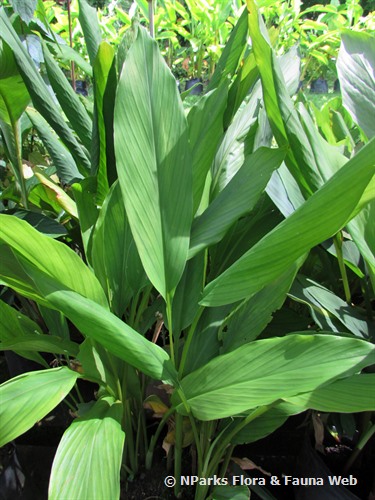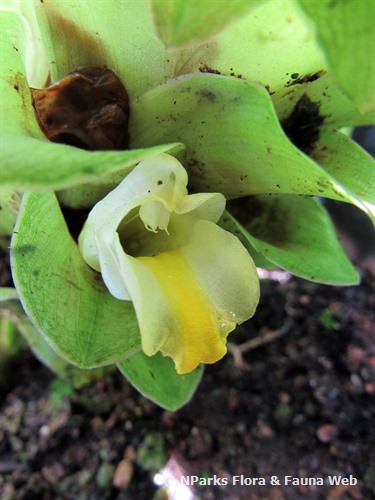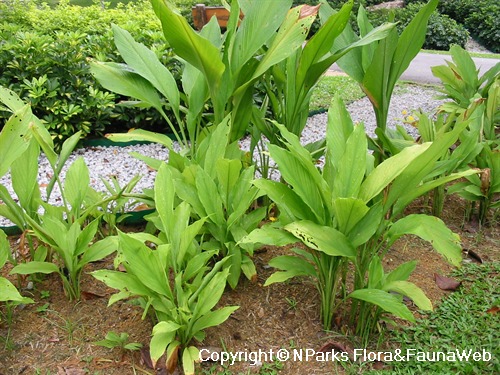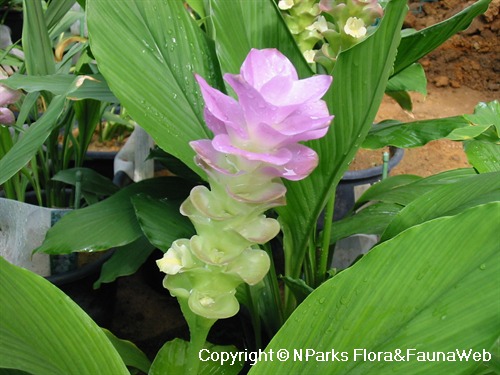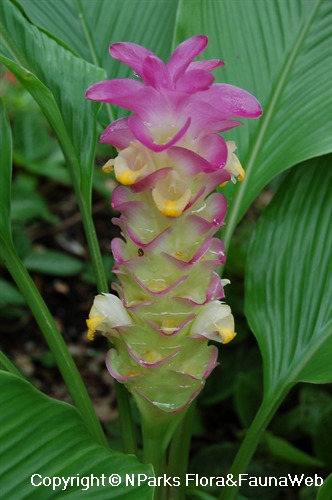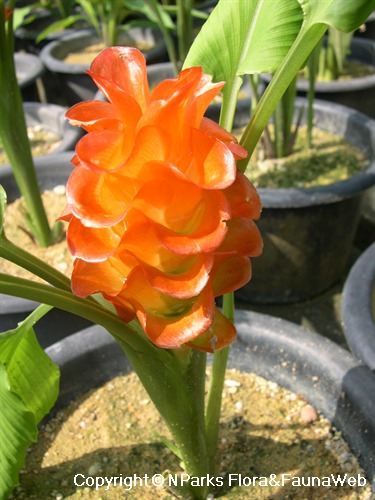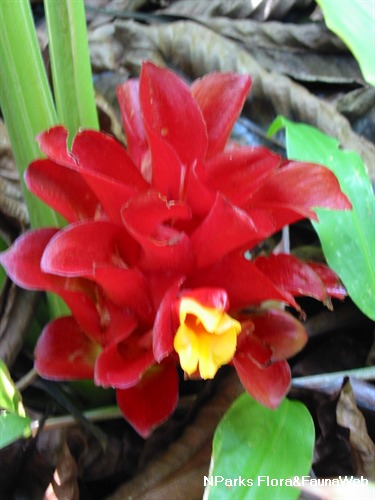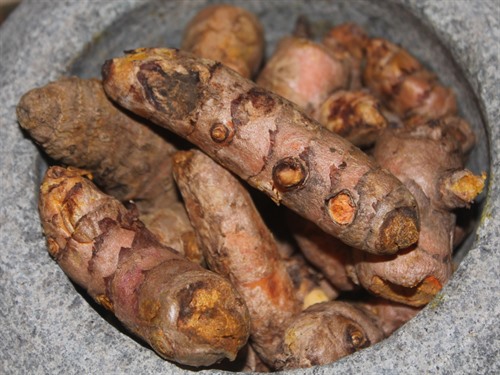
Back
Curcuma longa L.
| Family Name: | Zingiberaceae |
| Synonyms: | Curcuma domestica |
| Common Name: | Turmeric, Kunyit, 黄姜 |
Turmeric is a key spice in South Asian and Middle Eastern cuisine, adding a bittersweet flavour and a bright yellow colour to curries. It is extracted from the rhizome, an underground horizontal stem that resembles a thickened root. Turmeric is a valuable medicinal herb due to its anti-inflammatory and antimicrobial properties.
Name
Classifications and Characteristics
| Plant Division | Angiosperms (Flowering Seed Plants) (Monocotyledon) |
|---|---|
| Plant Growth Form | Herbaceous Plant |
| Lifespan (in Singapore) | Perennial |
| Mode of Nutrition | Autotrophic |
| Maximum Height | 1 m |
Biogeography
| Native Distribution | South Asia and Southeast Asia |
|---|---|
| Native Habitat | Terrestrial |
| Preferred Climate Zone | Tropical, Sub-Tropical / Monsoonal |
Description and Ethnobotany
| Growth Form | It is a robust, perennial herbaceous plant that grows up to 1m tall. Several leafy stems grow in a cluster from thick rhizomes (thick, horizontal modified stems) and can slowly spread to form large clumps. |
|---|---|
| Foliage | The leafy shoots bear up to ten alternate distichous (arranged in two rows, one on each side of the stem) leaves. The leaves are dark green above, with a green midrib, and very light green underneath, densely studded with pellucid dots. The leaf blades are thin, elliptic to oblong-lanceolate, up to 70 cm in length. The petiole (leaf stalk) is up to 10 cm long, broadly furrowed with narrow, erect wings along the margins. |
| Stems | The rhizome (thick, horizontal modified stem) is fleshy with an ellipsoidal primary rhizome at the base of each aerial stem, ringed with the bases of old scale leaves. When mature, it bears numerous straight or slightly curved cylindrical lateral rhizomes, called fingers, which are in turn repeatedly branched at approximately right angles, thus forming dense clumps. Bright orange skin and flesh with young tips, white, a spicy smell is given off when the rhizome is bruised. When cut, the yellow sap stains fingers and cloth indelibly. |
| Flowers | The inflorescence is a terminal spike with multiple bracts and borne at the end of a leafy shoot. The lower bracts are pale green with white longitudinal streaks or white margins, while the upper bracts are white, sometimes pink-tipped. The bracteoles (small bracts, especially on the pedicel of a flower) are numerous, spirally arranged and densely hairy, forming pockets, each with flowers inside. The flowers are tubular, white to yellow-white, opening one at a time. |
| Fruit | It is not known to bear fruit or seed. |
| Habitat | This species is considered a cultigen, as it is not known to occur in the wild, although it has become naturalised in some places, such as in teak forests in East Java. It is currently cultivated widely in the tropics, mainly for its rhizome, and large-scale cultivation is primarily found in India and Southeast Asia. |
| Taxonomy | Described by Marco Polo as a vegetable with the properties of saffron, yet not saffron, Curcuma longa has been widely cultivated for use in food, medicine and as a dye since 600 BC. Native to South and Southeast Asia and a member of the ginger family, C. longa is today a very important spice in Asia. |
| Cultivation | It thrives in well-drained, fertile, loamy soils, preferring lots of water but unable to withstand waterlogging. Full sun encourages the yield of the plant, while light shade is beneficial but heavy shade will reduce the yield. The plant also dislikes draughty conditions. Vegetative propagation is carried out using rhizomes, with evidence showing that larger daughter rhizomes (fingers) grow more effectively and produce higher yields than mother rhizomes. Keep germinating rhizomes damp and warm, in a slightly shaded location. Fertilising may be done weekly using a general-purpose liquid fertiliser. Pests of C. longa include shoot borers, leaf-eating insects, suck insects and nematodes. Red spider mites have also been known to be an occasional problem in older plants. Leaf spot or leaf blotch and rhizome rot are important diseases of the plant, caused by fungi. It can be propagated by division or rhizomes. |
| Etymology | The genus name Curcuma is derived from the Arabic “kurkum” or “kunkuma” for turmeric or its saffron-like colour. The specific epithet longa is Latin for "long", possibly referring to the long leaves of the plant. |
| Ethnobotanical Uses | Edible Plant Parts : Edible Leaves, Edible Stems Food (Herb or Spice): The rhizome contains a pigment, called curcumin, which gives the rhizome its yellow-orange colour. Widely used in Asian dishes, such as a spice and dye in curry powder and other food, the ground rhizome is also used as a colouring agent in processed food and sauces and is a cheaper substitute for saffron. Harvested rhizomes are boiled and sun-dried for about a week before use, but may also be used fresh. Leaves are used to wrap around fish for flavouring during cooking. Medicinal: Scientific Evidence of Medicinal Properties: Based on clinical trials where the effect of Turmeric was studied on people, it provided relief from asthma (Jain et al., 1979), showed anti-cancer (Kuttan et al., 1987) and antibacterial (Alam et al., 2008) activities, as well as reduced abdominal pain (Niederau & Gopfert 1999, Bundy et al., 2004) and peptic ulcers (Prucksunand et al., 2001). Traditional Medicinal Uses: In Ayurveda, a popular system of traditional medicine in India, Turmeric is used to treat worms, gallstones, flatulence, arthritis and menstrual problems, as well as improve digestion and energy (Prasad and Aggarwal, 2011). It is important to note that some therapeutic effects from traditional medicinal uses of plants are not currently supported or verified by scientific research. Cultural / Religious: In Indian culture, turmeric paste is made into small idols of Lord Ganesha for devotional prayers during festivals and other auspicious moments. In certain parts of India, a piece of turmeric rhizome is worn as amulet to protect against evil spirits. Others: The rhizomes are used in Asia as a cosmetic to beautify the face and body and also as a cloth dye. Anecdotal evidence suggests that the plant may be used in gardens to deter ants, the exact reason unknown. |
Landscaping Features
| Landscape Uses | Flowerbed / Border, Parks & Gardens, Container Planting |
|---|---|
| Thematic Landscaping | Economic Garden |
| Usage Hazard - Cons Remarks | Yellow sap from rhizome caused stains on skin and cloths that are impossible or almost impossible to remove. |
Fauna, Pollination and Dispersal
| Fauna Pollination Dispersal Associated Fauna | Butterfly Host Plant |
|---|
Plant Care and Propagation
| Light Preference | Semi-Shade, Full Sun |
|---|---|
| Water Preference | Lots of Water |
| Plant Growth Rate | Fast to Moderate |
| Rootzone Tolerance | Fertile Loamy Soils, Well-Drained Soils |
| Pest(s) | Nematodes, Chewing Insects, Sucking Insects |
| Propagation Method | Storage Organ (Rhizome), Division |
Foliar
| Foliage Retention | Evergreen |
|---|---|
| Mature Foliage Colour(s) | Green |
| Mature Foliage Texture(s) | Smooth |
| Foliar Type | Simple / Unifoliate |
| Foliar Arrangement Along Stem | Alternate |
| Foliar Attachment to Stem | Petiolate |
| Foliar Shape(s) | Non-Palm Foliage (Lanceolate, Elliptical, Oblong) |
| Foliar Apex - Tip | Acute, Caudate |
| Foliar Base | Rounded / Obtuse, Cuneate |
| Leaf Area Index (LAI) for Green Plot Ratio | 3.5 (Shrub & Groundcover - Monocot) |
Non - Foliar and Storage
| Stem Type & Modification | Herbaceous |
|---|---|
| Specialised Storage Organ(s) | Underground (Rhizome) |
Floral (Angiosperm)
| Flower & Plant Sexuality | Unisexual Flowers , Monoecious |
| Flower Colour(s) | White, Yellow / Golden |
|---|
| Flower Grouping | Cluster / Inflorescence |
| Flower Location | Terminal |
| Inflorescence Type | Spike |
| Ovary Position | Inferior / Epipgynous |
| Flowering Habit | Polycarpic |
Fruit, Seed and Spore
| Reproductive Mode (non-Angiosperm) | Asexual |
|---|
References
| References | Alam, M.A., Ali, N.A., Sultana, N., Mullany, L.C., Teela, K.C., Khan, N.U.Z., Baqui, A.H., Arifeen, S.E., Mannan, I., Darmstadt, G.L. & Winch, P.J. (2008). Newborn umbilical cord and skin care in Sylhet District, Bangladesh: Implications for the promotion of umbilical cord cleansing with topical chlorhexidine. Journal of Perinatology 28: S61-S68. Bundy R., Walker A.F., Middleton R.W. & Booth, J. (2004). Turmeric extract may improve irritable bowel syndrome symptomology in otherwise healthy adults: A pilot study. Journal of Alternative Complementary Medicine 10: 1015-1018. Jain, J.P., Bhatnagar, L.S. & Parsai, M.R. (1979). Clinical trials of haridra (Curcuma longa) in cases of tamak swasa and kasa. Journal of Research on Indian Medicinal Yoga & Homeopathy 14: 110-120. Kuttan, R., Sudheeran, P.C. & Joseph, C.D. (1987). Turmeric and curcumin as topical agents in cancer therapy. Tumori Journal 73: 29-31 Niederau, C. & Göpfert, E. (1999). The effect of chelidonium and turmeric root extract on upper abdominal pain due to functional disorders of the biliary system: Results from a placebo-controlled double-blind study. Medizinische Klinik 94: 425-430. Prasad, S. & Aggarwal, B.B. (2011). Turmeric, the Golden Spice. In: Benzie, I.F.F. & Wachtel-Galor, S. (eds) Herbal Medicine: Biomolecular and Clinical Aspects, 2nd edition, Chapter 13. Boca Raton: CRC Press/Taylor & Francis. Prucksunand, C., Indrasukhsri, B., Leethochawalit, M. & Hungspreugs, K. (2001). Phase II clinical trial on effect of the long turmeric (Curcuma longa Linn.) on healing of peptic ulcer. Southeast Asian Journal of Tropical Medicine Public Health 32: 208-215. |
|---|
Image Repository
Others
| Master ID | 609 |
|---|---|
| Species ID | 1904 |
| Flora Disclaimer | The information in this website has been compiled from reliable sources, such as reference works on medicinal plants. It is not a substitute for medical advice or treatment and NParks does not purport to provide any medical advice. Readers should always consult his/her physician before using or consuming a plant for medicinal purposes. |

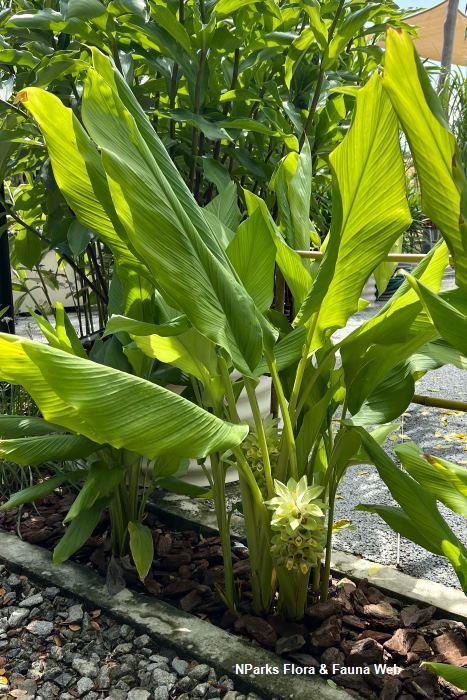
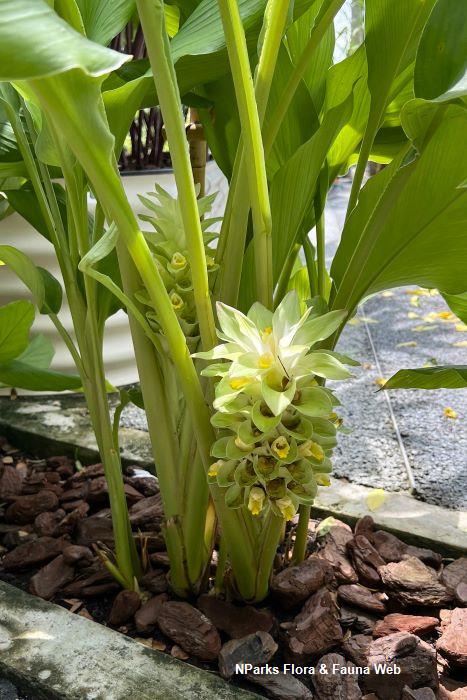
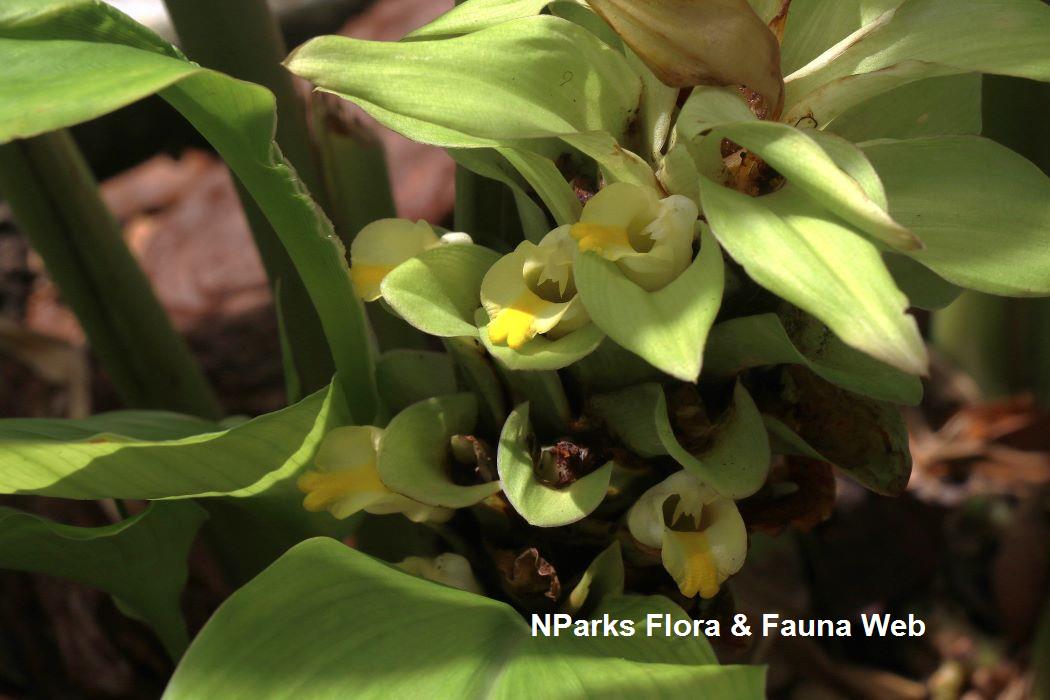
.jpg)
.jpg)
.jpg)
